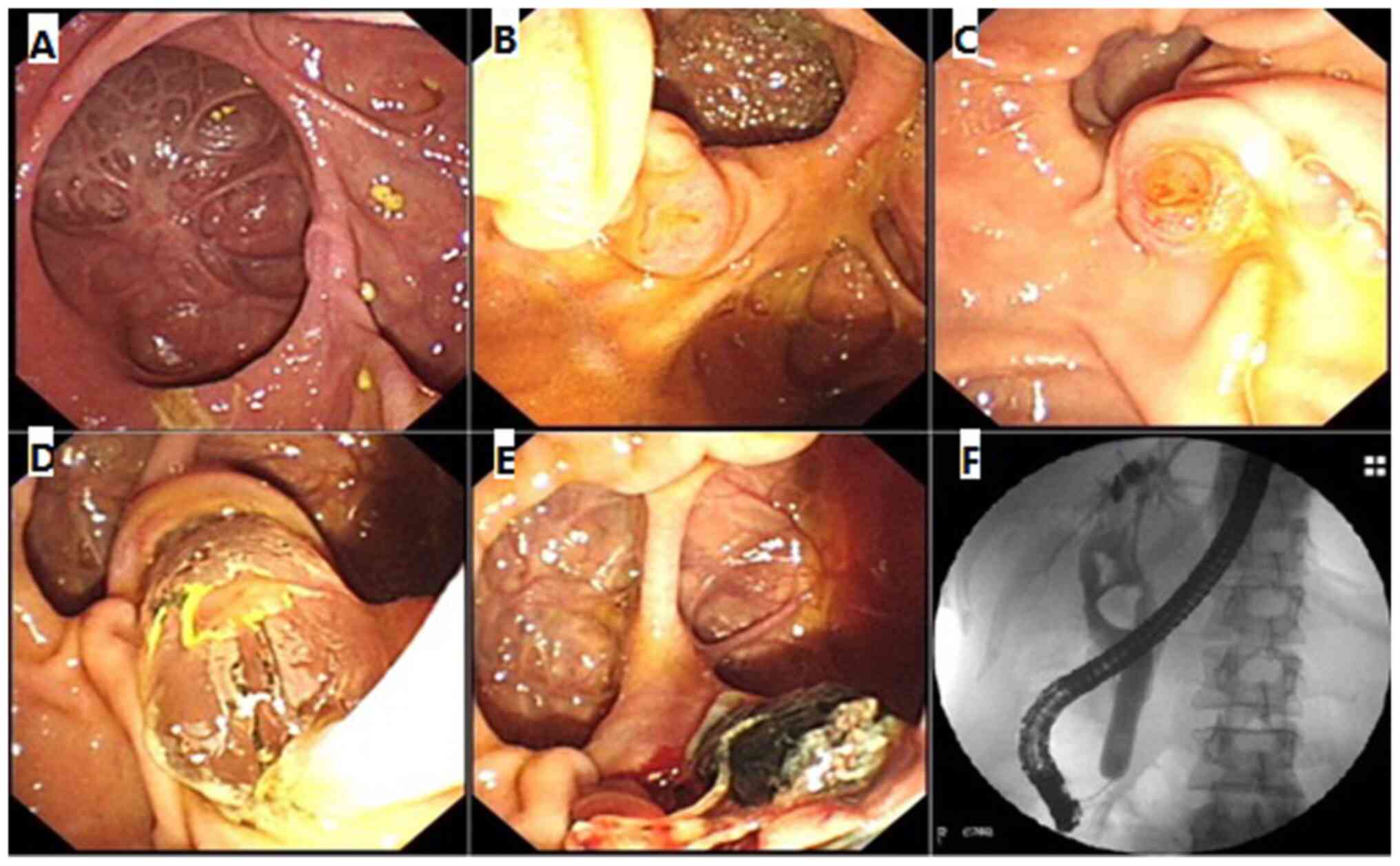|
1
|
Lobo DN, Balfour TW, Iftikhar SY and
Rowlands BJ: Periampullary diverticula and pancreaticobiliary
disease. Br J Surg. 86:588–597. 1999.PubMed/NCBI View Article : Google Scholar
|
|
2
|
Zippi M, Traversa G, Pica R, De Felici I,
Cassieri C, Marzano C, Occhigrossi G and Paoluzi P: Efficacy and
safety of endoscopic retrograde cholangiopancreatography (ERCP)
performed in patients with Periampullary duodenal diverticula
(PAD). Clin Ter. 165:e291–e294. 2014.PubMed/NCBI View Article : Google Scholar
|
|
3
|
Chen L, Xia L, Lu Y, Bie L and Gong B:
Influence of periampullary diverticulum on the occurrence of
pancreaticobiliary diseases and outcomes of endoscopic retrograde
cholangiopancreatography. Eur J Gastroenterol Hepatol. 29:105–111.
2017.PubMed/NCBI View Article : Google Scholar
|
|
4
|
Örmeci N, Deda X, Kalkan Ç, Tüzün AE,
Karakaya F, Dökmeci A, Bahar DK, Özkan H, İdilman R and Çınar K:
Impact of periampullary diverticula on bile duct stones and
ampullary carcinoma. Euroasian J Hepatogastroenterol. 6:31–34.
2016.PubMed/NCBI View Article : Google Scholar
|
|
5
|
Tyagi P, Sharma P, Sharma BC and Puri AS:
Periampullary diverticula and technical success of endoscopic
retrograde cholangiopancreatography. Surg Endosc. 23:1342–1345.
2009.PubMed/NCBI View Article : Google Scholar
|
|
6
|
Li X, Zhu K, Zhang L, Meng W, Zhou W, Zhu
X and Li B: Periampullary diverticulum may be an important factor
for the occurrence and recurrence of bile duct stones. World J
Surg. 36:2666–2669. 2012.PubMed/NCBI View Article : Google Scholar
|
|
7
|
Neoptolemos JP: Endoscopic sphincterotomy
in acute gallstone pancreatitis. Br J Surg. 80:547–549.
1993.PubMed/NCBI
|
|
8
|
Kim KH and Kim TN: Endoscopic papillary
large balloon dilation in patients with periampullary diverticula.
World J Gastroenterol. 19:7168–7176. 2013.PubMed/NCBI View Article : Google Scholar
|
|
9
|
Egawa N, Anjiki H, Takuma K and Kamisawa
T: Juxtapapillary duodenal diverticula and pancreatobiliary
disease. Dig Surg. 27:105–109. 2010.PubMed/NCBI View Article : Google Scholar
|
|
10
|
Karaahmet F and Kekilli M: The presence of
periampullary diverticulum increased the complications of
endoscopic retrograde cholangiopancreatography. Eur J Gastroenterol
Hepatol. 30:1009–1012. 2018.PubMed/NCBI View Article : Google Scholar
|
|
11
|
Liang K: Differential associations between
subjective age and depressive symptoms among urban and rural
Chinese older adults. Aging Ment Health. 24:1271–1277.
2020.PubMed/NCBI View Article : Google Scholar
|
|
12
|
Kim CW, Chang JH, Kim JH, Kim TH, Lee IS
and Han SW: Size and type of periampullary duodenal diverticula are
associated with bile duct diameter and recurrence of bile duct
stones. J Gastroenterol Hepatol. 28:893–898. 2013.PubMed/NCBI View Article : Google Scholar
|
|
13
|
Testoni PA, Mariani A, Aabakken L,
Arvanitakis M, Bories E, Costamagna G, Devière J, Dinis-Ribeiro M,
Dumonceau JM, Giovannini M, et al: Papillary cannulation and
sphincterotomy techniques at ERCP: European Society of
Gastrointestinal Endoscopy (ESGE) Clinical Guideline. Endoscopy.
48:657–683. 2016.PubMed/NCBI View Article : Google Scholar
|
|
14
|
Nakeeb A: Sphincter of Oddi dysfunction:
How is it diagnosed? How is it classified? How do we treat it
medically, endoscopically, and surgically? J Gastrointest Surg.
17:1557–1558. 2013.PubMed/NCBI View Article : Google Scholar
|
|
15
|
Zulli C, Grande G, Tontini GE, Labianca O,
Geraci G, Sciumè C, Antypas P, Fiocca F, Manes G, Devani M, et al:
Endoscopic papillary large balloon dilation in patients with large
biliary stones and periampullary diverticula: Results of a
multicentric series. Dig Liver Dis. 50:828–832. 2018.PubMed/NCBI View Article : Google Scholar
|
|
16
|
Chandrasekhara V, Khashab MA, Muthusamy
VR, Acosta RD, Agrawal D, Bruining DH, Eloubeidi MA, Fanelli RD,
Faulx AL, Gurudu SR, et al: ASGE Standards of Practice Committee:
Adverse events associated with ERCP. Gastrointest Endosc. 85:32–47.
2017.PubMed/NCBI View Article : Google Scholar
|
|
17
|
Tazuma S, Unno M, Igarashi Y, Inui K,
Uchiyama K, Kai M, Tsuyuguchi T, Maguchi H, Mori T, Yamaguchi K, et
al: Evidence-based clinical practice guidelines for cholelithiasis
2016. J Gastroenterol. 52:276–300. 2017.PubMed/NCBI View Article : Google Scholar
|
|
18
|
Sun Z, Bo W, Jiang P and Sun Q: Different
types of periampullary duodenal diverticula are associated with
occurrence and recurrence of bile duct stones: A case-control study
from a Chinese center. Gastroenterol Res Pract.
2016(9381759)2016.PubMed/NCBI View Article : Google Scholar
|
|
19
|
Hall RI, Ingoldby CJ and Denyer ME:
Periampullary diverticula predispose to primary rather than
secondary stones in the common bile duct. Endoscopy. 22:127–128.
1990.PubMed/NCBI View Article : Google Scholar
|
|
20
|
Miyazaki S, Sakamoto T, Miyata M, Yamasaki
Y, Yamasaki H and Kuwata K: Function of the sphincter of Oddi in
patients with juxtapapillary duodenal diverticula: Evaluation by
intraoperative biliary manometry under a duodenal pressure load.
World J Surg. 19:307–312. 1995.PubMed/NCBI View Article : Google Scholar
|
|
21
|
Lawrence C, Romagnuolo J, Cotton PB, Payne
KM and Hawes RH: Post-ERCP pancreatitis rates do not differ between
needle-knife and pull-type pancreatic sphincterotomy techniques: A
multiendoscopist 13-year experience. Gastrointest Endosc.
69:1271–1275. 2009.PubMed/NCBI View Article : Google Scholar
|
|
22
|
Panteris V, Vezakis A, Filippou G,
Filippou D, Karamanolis D and Rizos S: Influence of juxtapapillary
diverticula on the success or difficulty of cannulation and
complication rate. Gastrointest Endosc. 68:903–910. 2008.PubMed/NCBI View Article : Google Scholar
|
|
23
|
Tham TC and Kelly M: Association of
periampullary duodenal diverticula with bile duct stones and with
technical success of endoscopic retrograde
cholangiopancreatography. Endoscopy. 36:1050–1053. 2004.PubMed/NCBI View Article : Google Scholar
|










